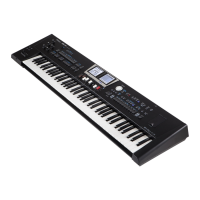Using the Metronome
55
CTRL button
Function Explanation
Pitch Up
By moving your hand over the D-Beam, you can
generate a value between “64” (no Pitch Bend)
and “127” (maximum upward bend). By moving
your hand outside the D-Beam’s range, the value
returns to “64” (no Pitch Bend).
Pitch Down
By moving your hand over the D-BEAM, you can
generate a value between “64” (no Pitch Bend)
and “0” (maximum downward bend). As soon
as you move your hand outside the D-BEAM’s
reach, the value returns to “64” (no Pitch Bend).
Modulation
Select this function if you want the D-Beam
to duplicate the modulation function of the
Bender/Modulation lever.
Cut Reso Up
(Only for Upper 1, 2)
By moving your hand over the D-BEAM, you can
vary the current TVF Cuto value.
Resonance parameter will be set to “+63”
(maximum), while the Cuto frequency can be
controlled between “0” (no change) and “+63”
(maximum increase). This allows you to create
some nifty lter eects that are particularly
useful for Dance/Techno music. When you move
your hand outside the D-BEAM’s range, both
Resonance and TVF Cuto return to their original
values (“0”= no change).
NOTE
* If TVF Cuto is already set to “+63”, you cannot
increase it using the D-BEAM Controller. In that
case, the following option is probably more
useful. Also note that some Tones already
use the highest possible TVF Cuto value by
default, in which case you cannot add more
overtones (by opening the lter even further).
Cut Reso Down
(Only for Upper 1, 2)
By moving your hand over the D-Beam, you can
vary the current TVF Cuto value.
The Resonance parameter will be set to “+63”
(maximum), while the Cuto frequency can be
controlled between “0” (no change) and “–64”
(lowest possible TVF Cuto setting). When you
move your hand outside the D-BEAM’s range,
both Resonance and TVF Cuto return to their
original values (“0”= no change).
NOTE
* The TVF Cuto frequency cannot be lowered if
TVF Cuto is already set to “–64”.
LWR Arpeggio 1 Octave ,
LWR Arpeggio 2 Octave ,
LWR Arpeggio 3 Octave
By moving your hand over the D-Beam, you
cause the D-BEAM part to play arpeggios
(broken chords) based on the notes extracted
from the current song. Depending on the setting
you select here, the notes will be arpeggiated
over 1, 2 or 3 octaves.
NOTE
* Do not forget to assign a suitable Tone to the
Lower part, which acts as “D-BEAM part”.
LWR Chord 1 Octave,
LWR Chord 2 Octave,
LWR Chord 3 Octave
By holding your hand inside the D-BEAM’s range,
you cause the D-BEAM part to sound the notes
extracted from the current song. You could use
this function to add syncopated brass or guitar
“hits” to your melody. The velocity value used for
playing these notes is “100”. The number (1, 2 or
3) bears on the octave of this “added chord”: 1=
Ab3~G4, 2= Ab4~G5 and 3= Ab5~G6. Move your
hand outside the D-BEAM’s range to stop the
D-BEAM part from sounding the chord.
NOTE
* Do not forget to assign a suitable Tone to the
Lower part, which acts as “D-BEAM part”.
Track Mute On-O
Same behavior of the [TRACK MUTE/CENTER
CANCEL] button .
Rotary HB S/F
Allows you to select the slow or fast speed of the
Rotary eect for the Harmonic Bars.
CTRL button
Function Explanation
Audio X-Fade
This function is used to activate a crossfade
between two les. To make this work, select a
dierent song while the current song is played
back and use the D-BEAM to activate the transi-
tion. The BK-9 creates a brief blend between the
current and the next audio song. (This function is
not available for SMF songs.)
Audio Key set Up
The D Beam can be used to start the phrases
of the last set you loaded (p. 70) either in
descending (going back to the preceding
memory) or ascending order.
Audio Key set Dw
MFX Control1
Same behavior of the MFX1 and MFX2 sliders.
See “Sound Eects for the real-time parts” (p.
34).
MFX Control2
D Beam Part View
Function Explanation
Volume
Use this parameters to set the volume of the
selected D-Beam instrument
Reverb Send
Use this parameters to set the Reverb and Chorus
Send Level to the D-Beam instrument.
Chorus Send
Panpot
Use this parameter to change the stereo placement
of the selected D-Beam instrument.
Using the Metronome
You can perform while the metronome sounds. You
can adjust the tempo or beat of the metronome.
If an SMF song or Rhythm is playing, the metronome
will sound at the tempo and beat of that song.
1. Press the [METRONOME] button so it’s lit.
The metronome will begin sounding.
To stop the metronome, press the [Metronome] button once again.
NOTE
The metronome is not available while an audio song le (mp3 or
WAVE) is selected.
MEMO
While rhythm or SMF song playback is stopped, the [TAP
TEMPO] button ashes in red to indicate the selected tempo
The metronome signal is sent to the BK-9’s METRONOME OUT jack
(rear panel). You can connect headphones to this socket and set the
metronome’s volume. See “External Volume” (p. 56). This option
may be useful as “click track” for a drummer.
Metronome Settings
The BK-9 also allows you to specify when and how the metronome should
sound:
1. Press and hold the [METRONOME] button.

